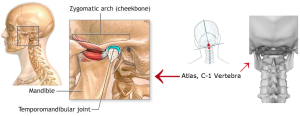“TMJ” or temporomandibular joint, refers to the connecting hinge between the lower jaw (mandible) and skull (temporal bone). TMJ disorders can be quite painful, making it difficult to eat, swallow, and yawn. Problems here can also contribute to headaches and neck pain. The image above depicts the location of this joint. Notice how close the first cervical bone (C1), or atlas, is to the TMJ. Because of this proximity, misalignment of C1 can actually be responsible for TMJ pain.
The delicate relationship between the head and neck changes when atlas loses its normal position. A structural imbalance here restricts joint motion and will apply abnormal amounts of pressure to muscles and ligaments. In some cases, this can impair normal TMJ function. If your jaw “clicks,” this is an indicator that structural misalignment could be present. (Click here to learn more about Upper Cervical Care.)
Patients with TMJ problems have a variety of dental options for treatment. While all can be effective, they’re not exactly cheap!
Upper Cervical Care won’t be the solution for every case of TMJ disorder, however, this approach is safe, non-invasive, and affordable. TMJ happens to be a condition that will respond very quickly if chiropractic care is the right choice… It won’t be weeks or months of painful waiting to find out.
If you’ve been struggling with TMJ, and you’re fortunate enough to have an Upper Cervical chiropractor close by, I recommend giving them a call. If you’d like some assistance locating a specialist in your area, I invite you to contact us and we help you.

